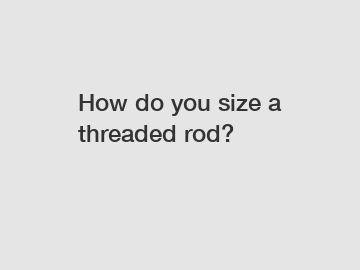How do you size a threaded rod?
How do you size a threaded rod?
Threaded rods are cylindrical rods with threads on the outer surface, commonly used in construction, engineering, and other industrial applications. Sizing a threaded rod correctly is essential to ensure proper functionality and safety. In this article, we will explore the process of sizing a threaded rod, step by step, to help you understand how to choose the right size for your specific needs.
Understanding the basics of threaded rods.

Before delving into the sizing process, it's crucial to have a basic understanding of threaded rods. These rods are available in various materials such as steel, stainless steel, aluminum, and brass, each with its own specific properties. They are commonly used to connect, anchor, or support objects and have threads that run along their entire length to facilitate attachment.
Identifying the requirements.
The first step in sizing a threaded rod is to identify the specific requirements of your application. Consider factors such as load capacity, thread engagement length, and the environmental conditions the rod will be subjected to. A thorough understanding of the intended use will help you select the appropriate material and size to ensure the rod can withstand the anticipated load and conditions.
Choosing the right diameter.
Once you have determined the load capacity and thread engagement length, you can move on to selecting the appropriate diameter for the threaded rod. The diameter will depend on the load requirements and the strength of the material used. Consult engineering design tables or calculators to determine the minimum diameter required based on the anticipated load.
Determining the thread pitch.
The thread pitch refers to the distance between the threads on the threaded rod. It plays a significant role in determining the compatibility of the rod with nuts and other threaded components. Choosing the correct thread pitch ensures a proper fit and facilitates secure fastening. Refer to standardized thread pitch tables to identify the appropriate thread pitch for your specific application.
Calculating the required length.
To determine the required length of the threaded rod, consider the objects being connected or supported and the clearance required between them. Measure the distance between the objects and add the desired clearance to determine the overall length of the rod. Remember to account for any extra length required for threading into nuts or other components.
Using load capacity charts.
In some cases, you may require certain load capacities for your threaded rod. These can vary based on the material and diameter chosen. Load capacity charts provide information on the maximum loads a threaded rod can handle under different conditions. Consult these charts to ensure that the selected rod meets your desired load capacity requirements.
Closing paragraph:
In conclusion, sizing a threaded rod is a crucial step to ensure its effectiveness and safety in various applications. By understanding the basics, identifying the requirements, choosing the right diameter, thread pitch, and calculating the required length, you can select the appropriate threaded rod for your specific needs. However, if you have any doubts or need assistance in sizing a threaded rod, do not hesitate to contact us. Our team of experts is always ready to provide guidance and support to help you make the right choice.
If you want to learn more, please visit our website 20mm hot rolled thread bar price, rolled rebar, different types of rebar.



Comments
0